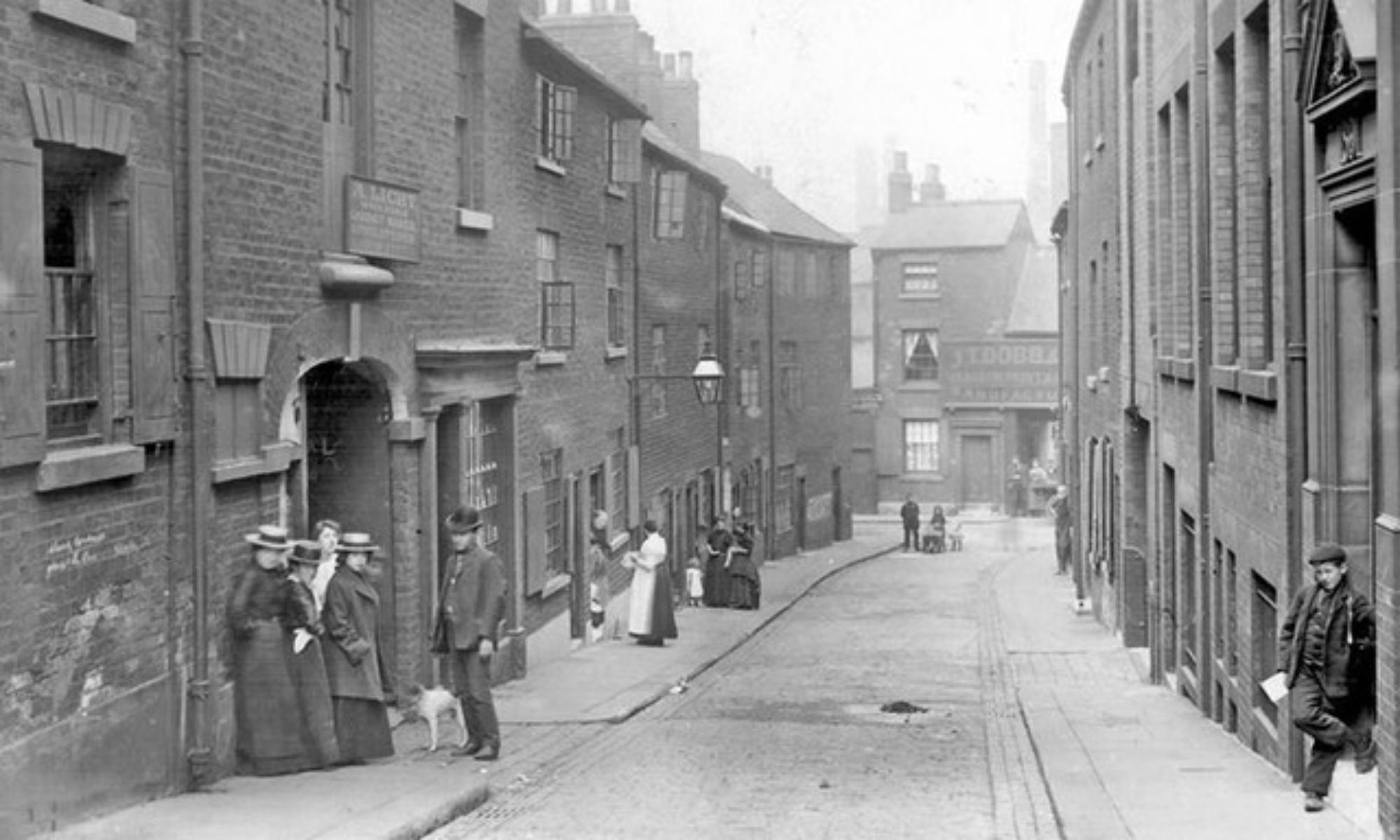Begin forwarded message:
From: ALAN SKEOCH <alan.skeoch@rogers.com>Date: November 22, 2020 at 12:41:49 PM ESTTo: Alan Skeoch <alan.skeoch@rogers.com>
EPISODE 176 PATRICK BELL…INVENTS FIRST REAPING MACHINE…TAUGHT SCHOOL IN FERGUS, C.W.alan skeochNov. 2020
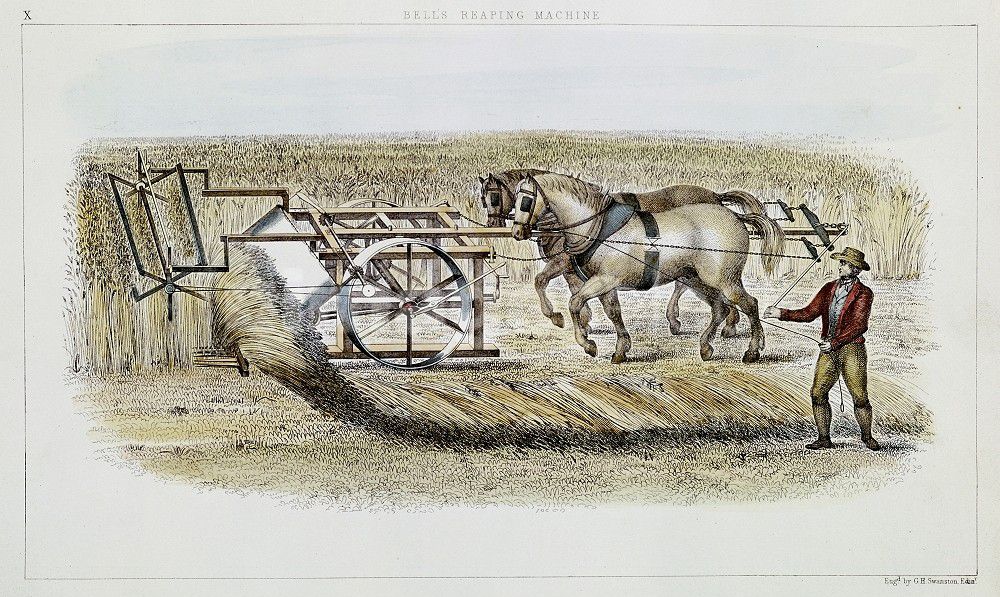

Then, much later another piece of unexpected good luck came when my interest in
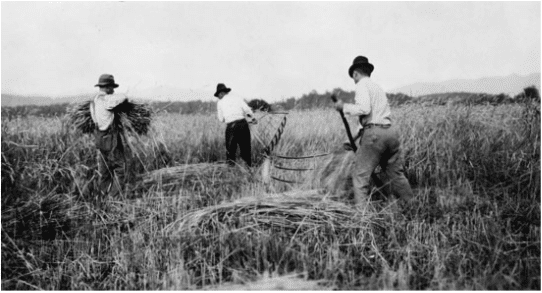
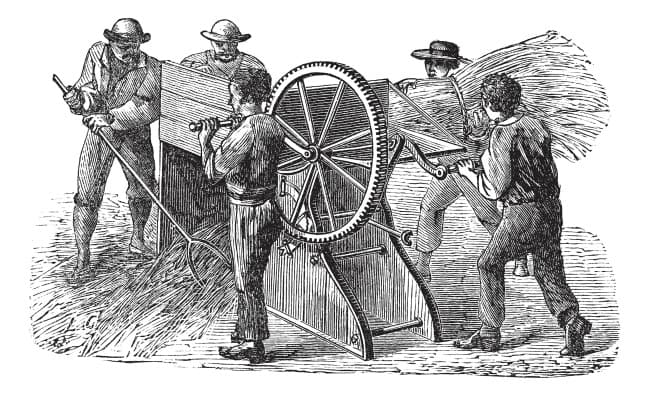

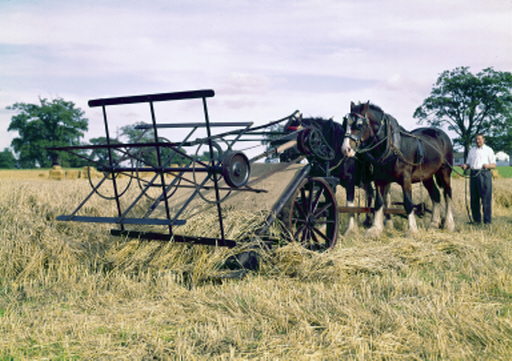
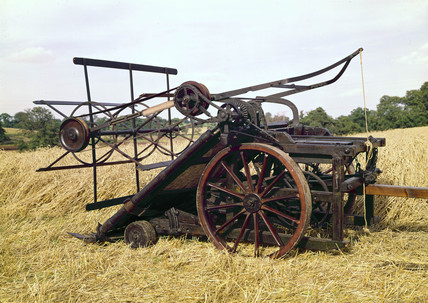
-
(Serendipity is a noun, coined in the middle of the 18th century by author Horace Walpole (he took it from the Persian fairy tale The Three Princes of Serendip). The adjective form is serendipitous, and the adverb is serendipitously. A serendipitist is “one who finds valuable or agreeable things not sought for.”) Persia is now Iran.This story has a lot of unexpected elements that came together and changed our lives. First was the‘goddamn’ rock in the master cylinder of Uncle Norman’s Massey Harris combine harvester. That happenedon the Skeoch farm located on the south west corner of the town of Fergus, Ontario ( called Upper Canada whenthe little Skeoch boys, James and John, arrived in 1846).In 1851, Patrick Bell left Scotland to teach school in Fergus. The Bell papers haveyet to be published. He kept a record of his life in Upper Canada… records that haveyet to be turned into a book although someone in the 1990’sis supposed to be doing so…or was doing so thirty year ago.Did Patrick Bell likely notice the Skeoch boys on the streets of Fergus. Did he teach them? Unlikelybecause education was reserved for the toffs of the town. Then again, Scots have always highly valued education.Maybe Patrick Bell and the Skeoch boys did come together but that is pure speculation. By 1851 the Skeochboys were teen agers. Busy farmers sons. No time for book learning.But just to think they came that close to each other… serendipity.
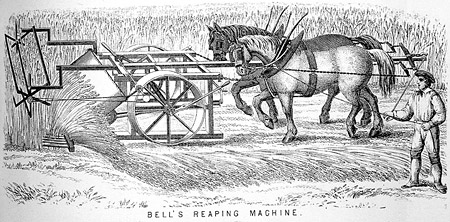
 The Bell Reaper and the modern Combine Harvester
The Bell Reaper and the modern Combine Harvester
 Patrick Bell did not become a farmer. Nor did he become a mechanical engineer. Nor did he become an inventorbeyond his Bell Reaper. Patrick Bell became a Christian minister in the Church of Scotland. No longertinkering with bull gears and bull wheels and reciprocating garden shears. And isn’t it serendipitousthat Patrick Bell came to Fergus to teach school in 1851? That is really weird.
Patrick Bell did not become a farmer. Nor did he become a mechanical engineer. Nor did he become an inventorbeyond his Bell Reaper. Patrick Bell became a Christian minister in the Church of Scotland. No longertinkering with bull gears and bull wheels and reciprocating garden shears. And isn’t it serendipitousthat Patrick Bell came to Fergus to teach school in 1851? That is really weird.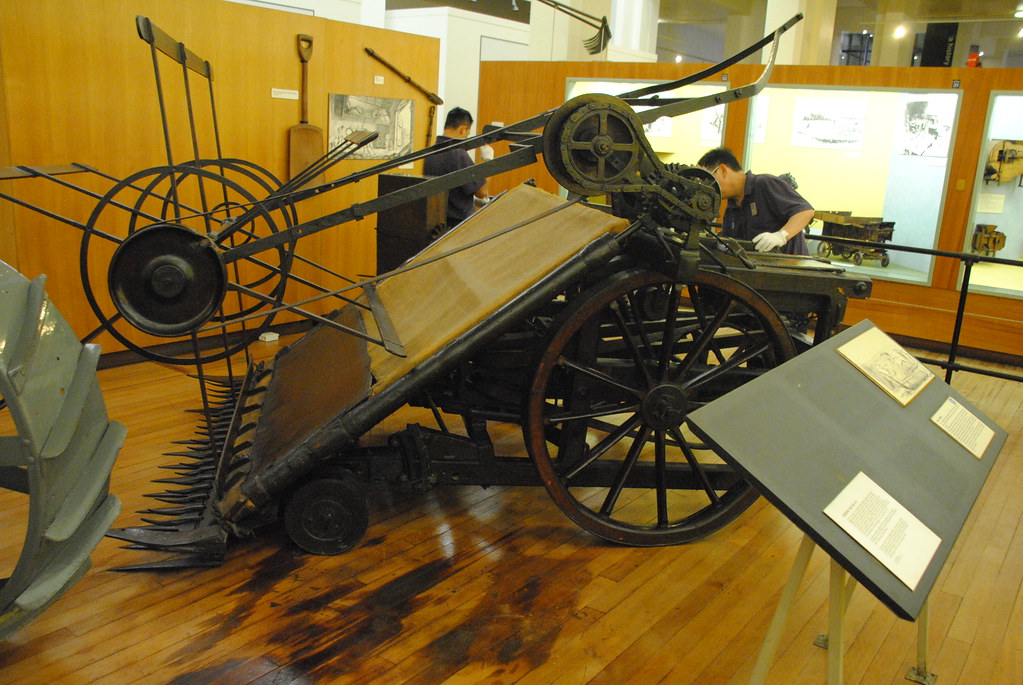 The Bell Reaper on dislay at the Science Museum in London, England. (Now removed to storage)BELL REFUSED TO PATENT HIS INVENTIONPatrick Bell was very different from the American inventor Cyrus McCormick. How? Bell refused topatent his inventor. He refused to make money from the invention of a machine that would makelife easier for human beings around the world. He encouraged others to improve his machine whichthey did and are continuing to do right now. Just look at those giants of the harvest fields today.Direct descendants of a machine imagined and built by a 27 year old farm boy, future Christian minister, futureschool teacher, in the barn on the Bell farm in Scotland.WHAT DOES THIS STORY HAVE TO DO WITH THE CALL FROM THE MELLON BANK OF NEW YORK?Remember, When I answered the phone call and accepted the project to rebuild aa McCormick Reaper I had never heard of Patrick Bell. To fully understandthe projects I undertook to research the history of reaping. Seemed a goodidea to do so. And that led me to Patrick Bell. Serendipity at work.The ‘goddamn rock’ in Uncle Norman’s combine set off ripples like a rock thrown in an Ontario pond.On March 1, 1976, my M.A. thesis was completed. Three hundred pages under the title “Technology and Changein 19th century Ontario Agriculture, 1850 to 1891. A massive tome of 300 plus pages. I think it was too muchfor my history professor Dr. J. M. S. Careless to read. In the school year, 1975-6, I was granted a year longsabbatical leave by the Toronto Board of Education to put my love affair with machines together. Copies ofthe thesis are held by the New York Sate Historical Society in Cooperstown, and Black Creek Pioneer Villagein North York courtesy of a request from Jim Hunter, collections department.WHAT A JOYMy work overlapped into three University of Toronto departments. First was the history department, thenthe Fine Arts Department chaired by Dr. Webster and finally the Engineering Department …then Bruce Sinclair, the School ofPractical Science…S.P.S. I still have a good feeling about that engineering department and the book‘Let use Honest and Modest’ by Bruce Sinclair and others. That was 46 years ago.. The SPS members were soincredibly helpful and actually interested in what I was trying to accomplish. At some pointa U. of T. history professor asked how long I expected to take. “Seven months”, I answered. His response wasa furrowed brow. Scepticism. I soon understood why the furrowed brow. There was a big bump in the road.THE BUMP IN THE ROADThere was one tricky side to this sabbatical. In 1976 an M.A. graduate student was expected to have reading levelfamiliarity with French. We were tested. I say ‘we’ because there were many fellow graduate students. I was two decades older than all of them.But accepted. Nice feeling. The French requirement, however, was a hurdle that most had trouble leapingover myself included. My first score was ‘zero’ which must sound terrible. In fact it was the mid pointbetween a score of -7 and +7. Most, perhaps all, of my fellow grad students scored the same or less. At leastI had high school French which most of them did not. My friends at Parkdale took great joy inmy ‘Zero”. After a lot of work I managed to get +3 on the second effort. That was a pass. How in hellmost of the kids I was with could be expected to translate a Syrian script in French I failedto understand. Soon afterward that French hurdle for graduate students was dropped.Why tell you this? Because the hurdle was way too high and failure to clear itled to a very amusing incident in my life. Perhaps offensive to purists. On my secondattempt at the reading level in French we lined up at the exam building on Queens Park Circle.One of our student leaders came over and said, “Al, you are number 4.”which meant nothing to me.“We’ll all meet for s beer after the exam.” Now that was fine by me. Nice to be accepted bykids twenty years younger than i was. The exam was hard but I soldiered my way through it.Then we went for a beer….about ten of us.“OK, Number 1, give me your sentence.”“And now Number 2…”“Number 3…”“And you, Al, what was the fourth sentence.”I failed to understand…did not know I was supposed to memorize the fourth sentence. Theplan was to memorize the whole exam then Parrot it back to our leaderwho would get the exam translated by someone that actually knew French.Then they would be ready for Test attempt Number Three. The plan wasboth funny and tragic. I did not believe the test would be the same paragraphsfor Test Number 3. So the whole effort was tragic. These kids, most of them,had never even taken Gr. Nine French. Eventually the U. of T. big shots musthave realized that fact and dropped the need for reading level in a second language.Although I failed my young friends I was flattered to be considered part of theconspiracy. We had a few laughs with our beer that afternoon. I credit my successwith the French requirement to Madam Schroeder at Humberside C.I. who kept mein the front seat because I made up words that did not exist. She was a great teacher.I will always be in her debt.END OF PART TWO: REAPING …
The Bell Reaper on dislay at the Science Museum in London, England. (Now removed to storage)BELL REFUSED TO PATENT HIS INVENTIONPatrick Bell was very different from the American inventor Cyrus McCormick. How? Bell refused topatent his inventor. He refused to make money from the invention of a machine that would makelife easier for human beings around the world. He encouraged others to improve his machine whichthey did and are continuing to do right now. Just look at those giants of the harvest fields today.Direct descendants of a machine imagined and built by a 27 year old farm boy, future Christian minister, futureschool teacher, in the barn on the Bell farm in Scotland.WHAT DOES THIS STORY HAVE TO DO WITH THE CALL FROM THE MELLON BANK OF NEW YORK?Remember, When I answered the phone call and accepted the project to rebuild aa McCormick Reaper I had never heard of Patrick Bell. To fully understandthe projects I undertook to research the history of reaping. Seemed a goodidea to do so. And that led me to Patrick Bell. Serendipity at work.The ‘goddamn rock’ in Uncle Norman’s combine set off ripples like a rock thrown in an Ontario pond.On March 1, 1976, my M.A. thesis was completed. Three hundred pages under the title “Technology and Changein 19th century Ontario Agriculture, 1850 to 1891. A massive tome of 300 plus pages. I think it was too muchfor my history professor Dr. J. M. S. Careless to read. In the school year, 1975-6, I was granted a year longsabbatical leave by the Toronto Board of Education to put my love affair with machines together. Copies ofthe thesis are held by the New York Sate Historical Society in Cooperstown, and Black Creek Pioneer Villagein North York courtesy of a request from Jim Hunter, collections department.WHAT A JOYMy work overlapped into three University of Toronto departments. First was the history department, thenthe Fine Arts Department chaired by Dr. Webster and finally the Engineering Department …then Bruce Sinclair, the School ofPractical Science…S.P.S. I still have a good feeling about that engineering department and the book‘Let use Honest and Modest’ by Bruce Sinclair and others. That was 46 years ago.. The SPS members were soincredibly helpful and actually interested in what I was trying to accomplish. At some pointa U. of T. history professor asked how long I expected to take. “Seven months”, I answered. His response wasa furrowed brow. Scepticism. I soon understood why the furrowed brow. There was a big bump in the road.THE BUMP IN THE ROADThere was one tricky side to this sabbatical. In 1976 an M.A. graduate student was expected to have reading levelfamiliarity with French. We were tested. I say ‘we’ because there were many fellow graduate students. I was two decades older than all of them.But accepted. Nice feeling. The French requirement, however, was a hurdle that most had trouble leapingover myself included. My first score was ‘zero’ which must sound terrible. In fact it was the mid pointbetween a score of -7 and +7. Most, perhaps all, of my fellow grad students scored the same or less. At leastI had high school French which most of them did not. My friends at Parkdale took great joy inmy ‘Zero”. After a lot of work I managed to get +3 on the second effort. That was a pass. How in hellmost of the kids I was with could be expected to translate a Syrian script in French I failedto understand. Soon afterward that French hurdle for graduate students was dropped.Why tell you this? Because the hurdle was way too high and failure to clear itled to a very amusing incident in my life. Perhaps offensive to purists. On my secondattempt at the reading level in French we lined up at the exam building on Queens Park Circle.One of our student leaders came over and said, “Al, you are number 4.”which meant nothing to me.“We’ll all meet for s beer after the exam.” Now that was fine by me. Nice to be accepted bykids twenty years younger than i was. The exam was hard but I soldiered my way through it.Then we went for a beer….about ten of us.“OK, Number 1, give me your sentence.”“And now Number 2…”“Number 3…”“And you, Al, what was the fourth sentence.”I failed to understand…did not know I was supposed to memorize the fourth sentence. Theplan was to memorize the whole exam then Parrot it back to our leaderwho would get the exam translated by someone that actually knew French.Then they would be ready for Test attempt Number Three. The plan wasboth funny and tragic. I did not believe the test would be the same paragraphsfor Test Number 3. So the whole effort was tragic. These kids, most of them,had never even taken Gr. Nine French. Eventually the U. of T. big shots musthave realized that fact and dropped the need for reading level in a second language.Although I failed my young friends I was flattered to be considered part of theconspiracy. We had a few laughs with our beer that afternoon. I credit my successwith the French requirement to Madam Schroeder at Humberside C.I. who kept mein the front seat because I made up words that did not exist. She was a great teacher.I will always be in her debt.END OF PART TWO: REAPING …
Papers of Reverend Patrick Bell (c 1799 – 1869)
Scope and Content
Journals of the Reverend Patrick Bell (c 1799 – 1869) kept during his visit to Canada, 1833 – 1837.
GB 231 MS 2317/1 – 2 Journal of travels between Great Britain and the province of Upper Canada, 1833-4.
GB 231 MS 2317/1 contains an itinerary of the journey from Great Britain to the Province of Upper Canada, describing his route through Dundee, Cupar (Fife), Glasgow, Isle of Man, Manchester and Liverpool; his passage to New York on board the Eagle, continuing up the River Hudson to Albany, and by Erie Canal to Queenstown, Canada, passing through Saratoga, Little Falls, Utica, Syracuse, Auburn, Lockport and Louisville, Jun 1833 – 1834. The volume is fully indexed and accompanied by a tabular record of daily temperature and weather conditions, Nov 1833 – Feb 1835; an account of a journey from Niagra Falls to the city of Fergus, township of Nichol, Apr 1834; and outline plans for his second volume, to include an account of agricultural practices in Upper Canada, notes on the natural history of the region and hints to emigrants, Jul 1835.
GB 231 MS 2317/2 is a fair (and slightly expanded) version of the first part of GB 231 MS 2137/1, and of another volume (or volumes) which has not survived. It begins in 1833 and ends 6 Mar 1834. The last page is inscribed Drummondvill Niagra Falls U.C. – Patrick Bell.
GB 231 MS 2318 Journal or rather observations made in Upper Canada during the years 1834, 35, 36 and 37.This is a continuation of Bell’s journal for the period 1834 – 1837; also containing weather observations, Jan 1835 – Apr 1837; thermometer readings at Quebec, 1832 – 1833; and temperature statistics for Montreal taken from a Montreal newspaper, 1826 – 1835.
Each volume described above is illustrated with sketches and diagrams of farm steadings, houses, agricultural implements, and detailed pencil drawings of plants and animals observed. His observations of people and places encountered are detailed, often amusing, and full of social and political comment (see in particular his account of the Campaign against the Swine in New York which terminated shamefully for those in power , GB 231 MS2317/1 p 50 – 52)
Administrative / Biographical History
Patrick Bell was born at Mid-Leoch farm, Auchterhouse, Dundee, c 1799, son of George Bell, tenant farmer there. He studied divinity at St Andrews University, and was ordained and appointed minister to the parish of Carmylie, Arbroath in 1843, where he remained until his death in 1869. He was for many years credited as inventor of the reaping machine, though the title now rests with John Common of Denwick, who invented a machine based upon the essential principals of the modern reaper in 1812, some 15 years ahead of Bell. The machine which Bell developed in 1827, whilst still a student at St Andrews, remained in regular use until c 1868, when it was purchased for the museum of the Patent Office. In recognition of his services to agriculture, he received a presentation from the Highland Society, subscribed for by the farmers of Scotland and others, and was awarded the degree of LL.D. by the University of St Andrews.
From 1833 – 1837 he travelled in Canada, where he seems to have found work as a private tutor. During this time he kept a detailed journal of his travels, making particular note of the geography, natural history, and agriculture observed.
